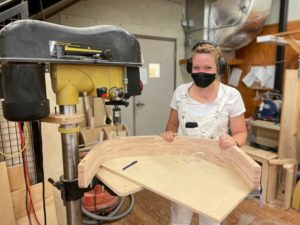Now that their 10-month program has come to a close, Camosun Fine Furniture and Joinery students are showcasing their final projects. Called An Arbutiful Life: Seating in Arbutus and Garry Oak, the show focuses on seating because chairs are complicated to make as they have to support the human body, says Camosun Fine Furniture and Joinery instructor Sandra Carr.
“A table is easy; a cabinet, same thing. It’s a bit more technical if you have doors and drawers, but to create something that can support the human body in a comfortable fashion is really challenging,” says Carr. “I mean, there’s a reason why architects will often design a chair… It’s really like a scaled-down architecture for people, basically.”
Camosun Fine Furniture and Joinery student Ken Makichuk used a focus on art deco and the arts and crafts movement, which hit North America in the late 1800s, for his inspiration behind his final project—a dining room chair.

“I like the complexity to art deco, the history related to it,” says Makichuk. “It was really influenced by the discovery of King Tut’s tomb, and the Olympics and stuff. It’s really complex, and it was very artistic and creative.”
Makichuck—who also has a clock and a cabinet in the show—has never worked with Arbutus before, and says the experience yielded a beautiful result, but getting there took a bit of getting used to.
“The wood was cracky,” he says. “It worked really, really well. Other than that, it was beautiful wood.”
All of the wood used for the show comes from the Vancouver Island Woodworker’s Guild wood-recovery program. Carr says that, ideally, the wood would still be on a tree, but the fact that it’s not means the wood deserves respect, especially two sought-after species like Arbutus and Garry oak.
“We really wish that it never got cut down and that we didn’t have it to work with; same with the Arbutus. That’s really the flip side of this,” says Carr. “I would never condone or want these trees to be cut down for the sake of lumber. Neither of them are commercial species. You can’t go to a store and buy them.”
Carr, who has worked with Garry oak and Arbutus for her whole career, says there is something really special about knowing where the wood comes from.
“I, myself, personally feel a sense of responsibility to the material to make something that’s aesthetically pleasing, that I would consider beautiful—of course, that’s subjective—and that’s really well-made and that’s going to last for—it sounds kind of cliché—but generations or hundreds of years. That’s the level that we’re aiming at. It’s the opposite of disposable—it’s not fast furniture. Even though we would rather that these local ecosystems remain intact, if they do have to come down, we’re happy to receive that gift.”
After completing his studies at Camosun, Makichuk hopes to get a job in a furniture shop making products. For him, the product is an artistic endeavour.
“I’ve been doing woodwork for a long time. I came to the class to really push myself and go to the next level,” he says. “And Sandra Carr taught me an incredible amount in a short amount of time. It was incredible. I was learning a lot. As I was designing this chair, I was changing it every day.”
As an instructor, Carr gives her students creative freedom within the confines of the assignment. Ergonomics and the factors that make seating comfortable or uncomfortable are given quite a bit of time in the course.
“There’s no one perfect solution to that,” says Carr, “because we come in all shapes and sizes.”
An Arbutiful Life: Seating in Arbutus and Garry Oak
Until Sunday, July 18, 10 am to 4 pm Fridays to Wednesdays
The Arts Centre at Cedar Hill Recreation Centre
